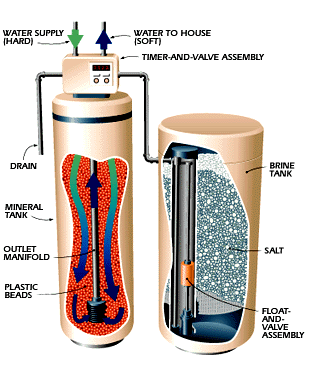This water softener diagram explains how a water softener basically works. And the different cycles it goes through to clean or regenerate itself.
1. The backwash phase removes dirt from the mineral tank. 2. Recharging the mineral tank with sodium from the brine solution displaces calcium and magnesium, which is then washed down the drain. 3. The final phase rinses the mineral tank with fresh water and loads the brine tank so it’s ready for the next cycle.
Water passing through the mineral tank loses positively charged calcium and magnesium ions to negatively charged plastic beads. The brine tank holds a salt solution that flushes the mineral tank, replacing calcium and magnesium ions with sodium. A meter at the top of the mineral tank regulates recharging cycles. The valve assembly routes water flow for each phase of the regeneration cycle.
Drinking Soft Water from a Water Softener
Drinking from a water softener system is not recommended. In most cases you should never drink soft water that comes from a water softener. By its very nature a water softener is designed to replace hardness with sodium. It is called a one for one ionic exchange. For example if you have 200 PPM of hardness it will often be converted to 200 PPM of sodium MOL. Our tests show you can expect an additional 20% in residual salt and sodium after that exchange in many cases. In other words 200 PPM of hardness could be be replaced with 240 PPM of sodium.
In all fairness we have seen some newer technologies that are not quite as high in sodium transfer. But you still should not drink the water fro them as it is still likely too high.
Companies
For example one of our tests showed that a Premium RainSoft Water Softener, if equipment with their finest resin, can often substantially lower the amount of sodium that is converted by their softener, it is still not advisable to drink from ANY water softener. You should always use reverse osmosis in the kitchen ($200), or drink bottled water if you have a water softener. Even with the instance of RainSoft, as they use independent dealers, you are always at the mercy of the dealer’s honesty on what type of mineral he chooses to use in his water softeners. RainSoft has different grades or quality of water softener minerals or resins.
Another company who seems to use only the finest softener resins is Budget Water Filters of America™, which is an online company who sells premium water softeners at a fraction of the cost of what the in-home sales companies sell them for. And unlike Culligan® or RainSoft®, they do not sell different grades and quality minerals, depending on what individual dealers decide. Water Filters of America™ only sells one grade. And that is the highest quality grade resins and minerals available. Simple.
Don’t drink water from a water softener.
EPA recommendations

The EPA maximum contaminant level (MCL) says that the maximum sodium allowed in water is 30 PPM, but that is very hard to find in their information. They will likely raise that number at some point to enable municipal water supplies to meet the standard more easily. Most labs set the maximum at 150 PPM. That is an extremely high number in our opinion, especially for frail people or people with high blood pressure. PPM (parts per million) and MGL (milligrams per liter) are the same.
AHA says max sodium is 20 ppm
Many states and organizations are now passing laws or are considering state laws limiting sodium to far lower amounts. We think anything over 20-30 PPM or MGL is too high. The American Heart Association sets 20 as its guideline for safe water for people, especially those with weakened immunity systems or other heart or medical issues.
Convert GPG to PPM or MG/L
If your test results are in GPG (grains per gallon) then you multiply the GPG times 17.1 to determine what the PPM number is. For example: 10 GPG converts to 171 PPM. 171 PPM of hardness is higher than the EPA maximum of 150 so the water would be beyond the MCL (maximum contaminant level) for safe drinking water. Using a water softener as an iron filter greatly increases this number and adds a great deal more residual sodium to the water. That is one of the many reasons you should never use a water softener as an iron filter.
If you have an iron problem you should use an iron filter. Then if the water is hard you would add a water softener after that. It is a common marginal practice for in home water treatment salesman to use a water softener as an iron filter. The iron will damage a water softener over time and will probably create expensive service calls; which turns into a lot of unnecessary expense with the company selling the water softener. It is a shame that money means more to them than your family’s health.
1 for 1 Ionic Exchange
The main point is this: If the water is high in hardness then once it goes through the water softener it will be high in sodium. If it is not high in hardness then you did not need a water softener to begin with. DON’T drink water that comes out of a water softener. Even if it should be below the MCL for safe drinking water, most people do not want unnecessary amounts of sodium in their drinking water. You don’t have to take our word for it either. Just take a sample of any water from a water softener that has high hardness going to it and take it to a lab to test for sodium and salt. The results will speak for themselves.
THE SOLUTION:
If the water is hard enough that you need a water softener then you must drink bottled water which is very expensive and often the bottled water is of low quality. Or you can add reverse osmosis ($199.87) to the kitchen sink and refrigerator to remove the sodium. Beware of in home sales companies selling reverse osmosis for $500 to $1500. There is no need for such ridiculous expenditures.
There are some people who say the water from reverse osmosis takes necessary minerals from the water. If you are one of these people just add a mineral cartridge to add to reverse osmosis that puts minerals back in the water. And makes the water more alkaline for under $30.
BUYERS BEWARE of Gimmicks
Beware of any company who tells you it is ok to drink the water from a water softener. Beware of any company who does not at least warn you NOT to drink water from their water softener. And that means ANY water softener. Also beware of companies selling magnets, electrodes, NANO technology, SWC components, GMX magnets, Nuvo H2O citrus based systems that add acid to the water. Or any other gimmick where they say their gadget will give you the same soft water a conventional softener will. They simply DO NOT give you real soft water.
Marginal Technology
There are numerous companies selling this sort of marginal technology locally and online. Substitutes can be acquired to replace sodium salt. However, there are drawbacks to these as well. For example you can use potassium chloride. It is great for making the softener environmentally friendly. Some people would prefer to drink potassium instead of sodium from normal softener salt. For the most part we don’t recommend drinking water that uses the water softener substitute called potassium chloride either. However, some people are on potassium restricted diets. And it can also adversely affect some medications. Hyperactivity medicines for children may want you to restrict potassium intake, for example. Certainly you should check with a doctor before injecting any additional chemicals in your water.
CONTACT US for HELPPlease do not hesitate to contact one of our expert techs for a discussion of this topic. They will not ask you to buy anything or pressure you in any way. And, our techs DO NOT work on commission either. Our techs will answer your questions to get you started in the right direction. You never have to buy anything at WaterFiltersOfAmerica.com to get good, honest and free advice.
Water Softener Diagram of How a Water Softener Works
QUESTIONS? Email Us

